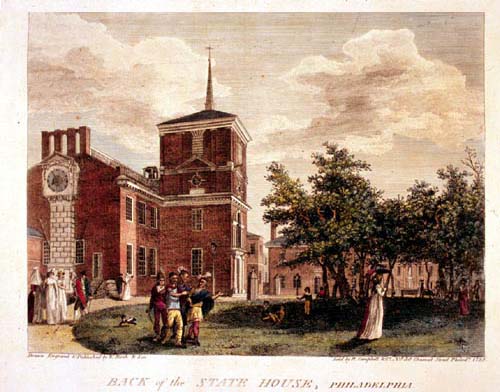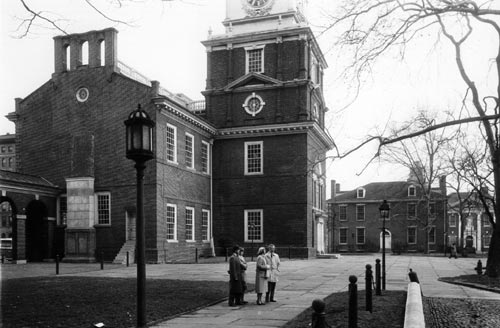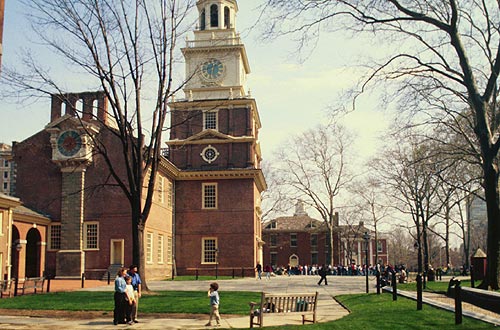Between 1750 and 1753 a tower with a wooden steeple containing a bell was added to the State House (Independence Hall).
The bell, which was originally cast in England, cracked on first ringing and was successfully recast in 1753 by two local "workmen," Pass and Stow. By order of the Assembly the bell was inscribed "PROCLAIM LIBERTY THROUGHOUT ALL THE LAND UNTO ALL THE INHABITANTS THEREOF - Lev. XXV X." It is believed that abolitionists in the 1830s, focusing on the words "all the inhabitants," were the first to refer to the bell as "Bell of Liberty" or "Liberty Bell." (Experts discredit the mythical story that the bell cracked while tolling for Chief Justice John Marshall who died in 1835) In 1752, by order of the Assembly, clock faces were added to the eastern and western walls of the State House just below the eaves. A masonry structure simulating a tall case clock, was built under the clock on the western wall, and a bell to strike the hours was housed in a turret on the roof in front of the tower. Thomas Stretch, a local clockmaker and son of the distinguished clockmaker Peter Stretch, was put in charge of the construction and maintenance of the clocks. By 1781 the steeple had dangerously deteriorated. It was taken down and replaced by a hip roof with a finial. The present steeple, designed by William Strickland, was erected in 1828 with a clock having four faces, a new bell and more ornamentation than the original steeple. No longer needed, the clock on the masonry tall case and the bell in the turret were sold to the Roman Catholic St. Augustine's Church. Both were destroyed when the church was burned during the anti-Catholic riots in 1844. Appearing to the right of the tower is Philosophical Hall (BG-M), built 1786-89 by the American Philosophical Society, the country's oldest learned and scientific society. Between 1794-1811 "Peale's Museum," a portrait gallery and museum of natural history, founded by Charles Willson Peale, was housed in Philosophical Hall (a sign displaying "MUSEUM" is over the door). In the distance is Library Hall.
Photographs
Independence Hall, the old State House, has undergone extensive restoration based on detailed research begun in 1951. The most obvious exterior change is the rebuilding of the tall case clock on the western wall to resemble the original 18th century clock. It replaced the remains of the 1896-98 reconstruction that was only the masonry dummy without a clock (seen in the 1960 view). Birch's engraving was a source for details.
Back Next




